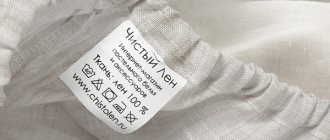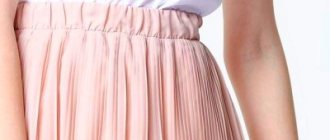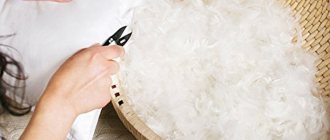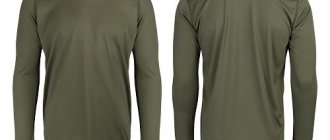Tatiana
I sew to order. I especially like to sew things from fleece: blankets, socks, sweaters. They are soft and cozy. I advise my clients to wash fleece clothing correctly so that after washing the items do not shrink or lose their softness. I share with you tips on how to wash fleece.
It is better to wash fleece by hand in warm water so that the fabric does not shrink, stretch, or deteriorate.
Which detergents to choose
The basis of fleece fabric is made up of synthetic fibers, so it requires special and careful care. Aggressive detergents and high-temperature water are not suitable for such material, and you will have to forget about the use of chemical stain removers altogether.
If you like to wash by hand, you can use regular laundry soap; it has good cleaning properties and does not contain aggressive components. But laundry soap is not suitable for washing in an automatic machine.
Fabrics made from synthetic fibers are perfectly compatible with liquid detergents, which are now available in a huge variety on the shelves.
Bleach containing chlorine should not be used under any circumstances. But what to do if, for example, coffee was accidentally spilled on a blanket and stains remained? In fact, it is very easy to remove stains from fleece fabric; you just need to soak the item for a while in warm water with the addition of liquid detergent. Even heavy dirt will disappear, and your clothes will become clean and fresh again.
A few rules for washing fleece items
In order for fleece items to please you and your loved ones for as long as possible, you need to know how to wash fleece and follow some rules when washing them:
- The most gentle method for this material is, of course, hand washing. This should be done in warm water, since temperatures above 30-40° can ruin your favorite things forever.
- First you need to dissolve the detergent well in water, and then you can start fighting dirt and stains.
- It is not recommended to wring out fleece items after washing; it is better to let the water drain from the fabric naturally. You can iron the material with your palms from top to bottom to get rid of excess moisture.
- If you are not particularly comfortable with hand washing and prefer an automatic machine, when washing fleece items, you must turn them inside out and fasten all existing zippers and buttons. Then during washing there will be no pulling or damage to the clothes.
- The machine drum should not be filled to capacity.
- The machine needs to be set to delicate mode (manual), the spin cycle set to minimum, or even better, do without a spin cycle at all.
- Machine drying should also not be used to avoid pilling or deformation of the fabric. After all, the quality may vary, so it’s not worth taking risks so that the clothes do not lose their original appearance over time.
- It is also not recommended to use conditioner for rinsing, since conditioner can destroy the water-repellent impregnation of fleece fabric.
How to make something made of wool shrink?
When restoring woolen items, you need to read the instructions for washing them and do the opposite. You just need to act carefully, without going to extremes.
To minimize the risk of product damage, it is recommended to work according to the following scheme:
- First, soak the affected sweater or hat in hot water. The duration of the stage should not be more than half an hour. The fluid temperature is set approximately 20 degrees higher than what is indicated on the label.
- After the specified time, rinse the woolen item using very cold water, you can even add a few pieces of ice to the liquid. A properly organized temperature difference can do a significant part of the work.
- Wrap the washed wool in a dry and warm terry towel. Remove excess moisture with blotting movements. Twisting woolen items is highly discouraged, especially a sweater, dress or jacket.
- Next, the clothes are dried. We lay hygroscopic fabric on a dense horizontal surface without visible relief. Lay a sweater or other item on top. It is advisable to direct flows of artificial heat onto the wool, then the shrinkage will be more dense. During drying, you need to give the item the desired shape with your hands, regularly adjusting the material so that it does not stretch.
Washing in a machine also causes strong shrinkage, but it is very difficult to control the process. As a last resort, a stretched sweater can be washed in a special mode for wool or hand washed, but the result can be unpredictable.
How to dry fleece
Washed clothes should be carefully straightened and hung on a line to dry. It is best, if possible, to dry clothes on hangers.
Do not dry on radiators, since exposure to high temperatures may cause synthetic fabric fibers to become deformed.
If it is too hot outside, it is better to dry things indoors; at room temperature they dry wonderfully, but hot air is not at all useful to them.
And ironing such delicate items is strictly prohibited, as evidenced by the crossed out iron on each label.
Treat fleece clothing and blankets with care and love, and then you will be able to enjoy their softness and freshness for a long time and use them with pleasure.
Fluffy blankets, warm clothes and modern sports jackets are made from fleece material. With proper care, a product made from this fabric will not lose its attractive appearance, softness and will last a long time. I'll tell you how to wash fleece and what products you can use.
Why does fleece pill?
This is synthetic wool, made in the following way: the pile is integral with the base, while its fibers are hollow, like air chambers. ... In addition, in cheap fleece, the pile is simply glued to the base by hardworking Chinese hands. It quickly rolls down, losing its heat-saving qualities.
Interesting materials:
How many days off are there in November? How many days off for New Year 2020 Ukraine? How many days off are there according to the Labor Code? How much child benefits are paid to large families? How much is sick pay? How many h1 headings should there be on a page? How much does an IT specialist earn in Kyiv? How much does a janitor earn in the USA? How much does Epic Games earn? How much does an engineer earn in Canada?
Suitable detergents
Fleece is a synthetic knitted material made from polyester. It is a wool substitute and is not as demanding on detergents as natural material:
| Photo | Characteristics |
| Remedy 1. Liquid gels and powders. Synthetic fibers are easily cleaned with liquid products. Ordinary powders are difficult to wash out of dense fleecy fabric. | |
| Remedy 2. Laundry soap. To get rid of stains, use 72% soap. It is effective for heavy soiling. It is enough to rub the stain with soap and wash it under running water after 5 minutes. This fabric is easy to wash.
| |
| Remedy 3. Conditioner. Add conditioner during the final rinse to soften the fluff and remove static electricity. Fleece items are subject to electrification. |
Bleaching knitwear
To maintain the normal appearance and quality of the product, you must follow some rules for washing and bleaching the material.
It is important to use only approved products, do not experiment, so as not to get disastrous results.
Products for bleaching knitted items:
One of the most gentle and effective methods of whitening is German salt for stains Sil. Valid at 20°C. Active oxygen removes stains from fruits, red wine, coffee, lipstick. Directions for use: dissolve 50 g of powder in 4 liters. Place the laundry and stir. Leave overnight. Rinse. Wet the clothes with water, rub with 72% laundry soap to create a rich, dense foam. Leave to soak for 20 minutes. Water temperature 30-40 °C. Rinse things several times. Resuscitate with ammonia. Mix a bottle of ammonia with 10 liters of water at a temperature of 20-30 °C. Place the faded knitted item in the solution for 10 minutes.
Wash, rinse twice. Use Vanish for white, but with caution. Using a measuring spoon, apply the gel to the stain and rub in with the dispenser.
Leave for 10-15 minutes. For soaking, add 100 ml of Vanish to 4 liters of water, water at a temperature of 20-40 °C. Soak for no more than 30 minutes. Amway is a universal bleach for all types of fabrics. Dissolve the liquid product in hot water, add cold water until the temperature reaches 30 °C. Soak dirty knitwear overnight. Wash as usual, rinse well. With the help of mustard powder you can rid knitwear of grayness and stains. 4 tbsp Dilute the product in 1 liter of hot water and wait until dissolved. Add cold water so that the temperature is no more than 40 °C. Place the product in the solution, wash after 30 minutes and rinse twice.
For severe stains, when home whitening does not help, seek professional help. In-salon dry cleaning will remove any stains without damaging the fibers of the material.
Method 1: hand washing
| Image of stages | Instructions |
| Step 1: Removing Stains Before washing the product, remove stains and heavy soiling:
| |
| Step 2: Preparing the Detergent Dilute the gel or liquid powder in water. At what temperature is the washing and rinsing process safe for fleece items: from 30 to 40 °C. | |
| Step 3: Soak and Hand Wash Immerse the item in the detergent solution for 10 minutes and then wash it by hand. | |
| Step 4: Rinse Thoroughly rinse the solution out of the lint. Add conditioner during the final rinse. | |
| Step 5: Spin Let the water drain from the hanging item. | |
| Step 6: Drying Unfold the fleece blanket and hang it on a rope. Place the clothes on a hanger.
|
Method 2: in the car
Is this material machine washable?
:
- Items made from 100% fleece can be machine washed in the “synthetic” mode.
- Products with added cotton will shrink when pressed. Disable this feature.
- If improperly washed, a fleece thermal jacket will lose its properties. This requires a special product and a delicate regime.
To keep things warm, light and dense, you need to wash fleece according to the following rules:
| Image | Proper machine wash |
| Rule 1. Prepare your things Turn the clothes inside out, fasten the zippers and buttons. This will prevent stretching and damage to the products. Do not overload the drum of the machine so that the pile is rinsed thoroughly. | |
| Rule 2. Use special laundry balls. The best option for washing a fleece blanket: place 2 balls in the drum. They prevent the formation of pills, improve the quality of washing, and add softness. | |
| Rule 3. Set the delicate mode with a minimum number of revolutions. Fleece fabric has average mechanical strength and wear resistance. Intensive machine washing will damage the material. | |
| Rule 4. Dry outdoors in the shade or in a ventilated area. When machine dried, the pile will roll up. I also don’t recommend placing synthetic items on radiators, as they can become deformed. |
Washing a jacket
| Photo | Recommendations |
| Tip 1: Clean fleece clothing according to label directions. | |
| Tip 2. Use special products for sports membrane clothing. The price of the product is about 420 rubles.
| |
| Tip 3. Dry by laying it horizontally on the dryer. So keep the shape of the sports product. |
Shrinkage of the product after washing
Does fleece shrink?
:
- 100% polyester does not stretch or shrink.
- Polyester with the addition of cotton will shrink from high temperatures and intense spinning.
If fleece shrinks after washing, use vinegar
:
- Pour 100 g of vinegar into 5 liters of cold water.
- Soak the item for half an hour.
- Without squeezing, hang out to drain.
- During the drying process, manually stretch the product several times to its original size.
What is polyester, what properties does the fabric made from this material have?
This material means a synthetic fabric, the production of which uses a melt of polyethylene terephthalate and its derivatives.
To improve the aesthetic qualities of the finished fabric, polyester fiber is combined with other types of raw materials: nylon, elastane, cotton, viscose.
Wardrobe items made 100 percent of polyester, as well as mixed materials containing polyester, have the following properties:
- Long service life. Durable material is resistant to strong mechanical stress. It does not wear out and does not lose its original qualities even after numerous washes.
- Color fastness. The material is able to maintain color brightness throughout the entire period of operation. It does not fade when in contact with water and does not fade in the sun.
- Resistance to deformation. Polyester items, especially those containing nylon or elastane fiber, retain their original shape after repeated washing and strong stretching.
- Resistance to the negative effects of aggressive substances, as well as the development of pathogens.
- Low pillability (pellets do not appear on the product).
- Dust and dirt resistance. The fabric retains any type of contaminant on the surface, preventing it from penetrating into the fibers.
- Ease.
- No tendency to absorb unpleasant odors.
- Ability to dry quickly.
- Low creasing. Most wardrobe items do not require ironing.
- Availability. When producing polyester products, manufacturers focus on the average consumer.
- Moisture resistance.
- Easy to care for. If you follow the recommendations for washing items made from this fabric, they will not shrink or fade.
In addition to the positive aspects, clothes made from this fabric also have disadvantages:
- low air circulation in the fibers - due to difficult air exchange in polyester products, it is uncomfortable in hot weather;
- electrification - this fabric has a tendency to accumulate static electricity;
- there is a high risk of skin irritation;
- difficulty of staining;
- fear of high temperatures - when washed in hot water, polyester products shrink.
Conclusion
Now that you know how to wash textured fleece material, you can preserve its properties and enjoy the softness and freshness of your items. The video in this article will help you and provide you with recommendations. Ask your questions in the comments if you need to clarify any nuances.
Fleece is a unique fabric in terms of softness, which many people mistakenly mistake for natural. For this reason, housewives begin to wash fleece items incorrectly, causing the fibers to thin. The material ceases to retain heat, and the functional properties of the item gradually drop to zero.
Like any synthetics, fleece reacts negatively to aggressive detergents, high temperatures and professional stain removers. But even at home, it is possible to provide the fabric with complete care, ensuring that the product is maintained in optimal condition.
Fleece for newborns, can it be used?
You can dress children and newborn babies in fleece. You just need to understand why and how to do it correctly.
Fleece is a hypoallergenic fabric; it itself does not cause irritation, itching, etc. In this regard, fleece clothing can be a good alternative for children who have some skin sensitivity to natural materials.
Secondly, fleece is a moisture-wicking garment due to its properties and porous structure. But it must be used correctly. We discussed how to wear fleece above.
Otherwise, the decision is the prerogative of the parents.
Rules for caring for fleece and features of its processing
Before washing a fleece blanket, soft jacket or neat hat, you need to read the manufacturer's recommendations on the label; approaches may vary markedly.
In addition, it is worth considering the universal rules for processing capricious products:
- Despite the fact that fleece products can be cleaned in the washing machine, it is still better to handle them by hand.
- The drum cannot be loaded to the limit; things must remain free, otherwise they will quickly wear out.
- To properly wash fleece, you need to turn all items inside out, having first fastened all the zippers.
- To obtain the maximum positive result, it is recommended to pre-soak items in a soapy solution, but no more than half an hour.
- Bleach, solvents and dry cleaning are strictly prohibited, so these items can only be processed at home. Instead, you need to use gentle or specialized products that restore the water-repellent properties of the fabric.
- After processing in a washing machine or prolonged wear, static electricity often begins to collect on fleece items. This will not happen if various conditioners are added to the water during cleaning.
- Regardless of how you washed a blanket or other product, wringing out the fabric is prohibited. After processing, it is laid out on a horizontal surface or hung on hangers, allowing the liquid to drain freely.
- Drying fleece items is only permissible naturally. Exposure to artificial heat sources quickly destroys the product, rendering it completely unusable.
Tip: The formation of pellets on the surface of an item after the cleaning procedure is quite normal. Problem areas simply need to be treated with an old, dull razor or an electric razor designed for long hairs.
Rules for washing fleece products
Proper care of the material will allow you to preserve the presentation of the product made from it for a long time. And although fleece fabric is easy to care for, you still need to wash products made from such material with caution - it is included in the group of delicate ones.
To prevent pilling, damage and elongation of products, before washing they must be shaken out, turned inside out, zippers and buttons fastened.
It will help you choose a washing option by studying the information on the label attached to each model. The label displays, in particular, the type of washing - hand, machine or both, the ability to select temperature conditions, detergent and bleach, whether ironing is necessary or not.
How to properly wash fleece in a machine and by hand?
When starting to directly process items in an automatic washing machine, you must take into account the following recommendations from professionals and experienced housewives:
- Washing blankets or more complex fleece items in hot water is prohibited. The indicator should not exceed 30-40ºС. Even if the pollution seems very persistent, this rule cannot be broken.
- When looking through the options for a washing mixture, it is better to give preference to the most delicate products. In extreme cases, fleece can be washed with laundry soap, but it is better if it is a neutral gel with soft enzymes. A water softener, for example, must be added to the powder product. It can be up to a quarter of the total volume of detergent.
- The mode can only be delicate or manual. As a last resort, we independently reduce the speed in the washing machine to a minimum.
- To wash colored fleece and maintain its brightness, you need to add color stabilizers. Bleach is used only when processing white products.
- Spinning and drying on the washing machine must be turned off, otherwise the entire delicacy of the approach will be reduced to a minimum.
- Fleece items are not ironed, they are simply given time to hang out. If all cleaning procedures were carried out taking into account the rules, then after drying, the item will return to its original shape.
Some housewives try to wash fleece using a steam cleaner, but this is not the safest option. If you are lucky, the fabric after such treatment will only become slightly thinner, but it may also become hopelessly deformed. There is no need to invent complicated options for cleaning fleece. Even in warm water, it perfectly gets rid of dirt with minimal mechanical assistance from the outside.
Fleece is a popular fabric that provides warmth in cold weather. We decided to put together a guide that explains what fleece is, how much warmer it is than wool, and whether it can be ironed.
This is a polyester or polyester fabric. Polyester is melted into very fine threads that are woven together, similar to knitting. The polyester fabric is pulled over rotating metal brushes, which pull fibers from the small loops of the fabric and fluff them up. And the already treated side becomes soft, fleecy and looks like the fleece we are used to.
How to wash fleece?
Before washing, turn the fleece inside out and zip up all pockets. If your clothes are heavily soiled, soak them for 1-2 hours so that the dirt can come off quickly. Wash fleece with laundry soap.
When washing in a washing machine, fleece clothing should occupy no more than 1/2 of the drum. Choose gentle modes: click, outdoor, wool. 30-40 ºС will not ruin fleece clothing. Bleach, conditioner and stain remover - fleece will not withstand and will lose its warming properties. When washing in a washing machine, use liquid detergents.
After washing, clothes should not be wrung out. If a lot of water drains from the fleece, place a basin and remove excess water with your palm. Dry the fleece flat at room temperature. Drying it on the balcony is not the best option, because the sun can literally dry out the warming properties of clothes.
What temperature is fleece rated for?
When choosing fleece clothing, it is necessary to take into account 2 criteria: the intensity of physical activity and the ambient temperature. During intense physical activity, you sweat more. To prevent clothes from getting wet, it is important to choose fleece made of breathable material. The breathability of a material is its ability to remove moisture evaporation. Ventilation is ensured not only thanks to the breathable material of the product, but also due to multifunctional zippers. By unfastening or fastening them, you can control the level of ventilation depending on the load. A collar with a zipper, a front zipper, side zippers - everything comes into play. With less intense exercise, we warm up more slowly and sweat less.
Depending on the weather, you will need cooler or warmer fleece clothing. For cool weather (above 7°C) choose micro fleece: high quality fleece, which has the advantages of being lightweight and compact. For cold weather (below 7°C), use long pile fleece (material with large curls or long fibers on the inside or outside). The material retains more air and provides better thermal insulation.
Can fleece be ironed?
Ironing, steaming and drying on a radiator is prohibited, otherwise the fabric will be damaged.
It is enough to dry it flat. By the way, don’t forget to look at the label with recommendations, because it will always tell you how to care for your clothes. In everyone's wardrobe you can see a fleece sweater, sweatshirt or jacket. These things are very comfortable and cozy, so I want them to last as long as possible. How to wash fleece according to all the rules? Experienced housewives share their secrets.
What is warmer, fleece or wool?
When comparing wool and fleece, do not forget that fleece is the second layer, which is worn, for example, on thermal underwear.
Ideal warmth can be achieved by combining a natural first layer with fleece on top.
The technical characteristics of wool and fleece are similar, but only in a dry state.
As fabrics become wet, such as from rain or sleet, fleece begins to outperform wool in terms of warmth and heat retention.
Automatic washing machine
You can wash fleece in a washing machine, as this material is quite durable. But in order for fleece items to be warm, airy and at the same time dense, like new ones, even after washing, you need to choose the right temperature and washing mode. You cannot wash such clothes at temperatures above 40 degrees.
You need to wash off stains on clothes before putting them in the washing machine. This should be done this way: dilute a mild detergent in a basin of warm water, and then manually wash off the stains. Only after this the product can be sent to the automatic washing machine.
But, in addition to observing the temperature regime, a number of recommendations should be followed:
- Such products cannot be twisted, otherwise they will stretch. You need to choose a mode without spinning or wash the item manually.
- When washing in automatic mode, the item of clothing must be turned inside out and all zippers and buttons fastened. This is important advice - such fabric is washed only from the wrong side.
- When washing such items in an automatic machine, you should always select the hand wash mode and the water stop. This way things won’t get crumpled, and all you have to do is squeeze them lightly with your hands and dry them gently.
- Not everyone knows how to properly wash fleece items and what powders to use. Only mild detergents are used to maintain the breathability of this fabric.
Manual cleaning of clothes
Hand processing allows you to wash fleece thoroughly and accurately. In some situations, manual processing is indispensable. For example, if a bulky blanket does not fit into the drum of a washing machine.
If you need to remove stains, you can cope with the task as follows:
- Fill a basin with cold water.
- Immerse the product in it.
- Leave for a quarter of an hour.
The use of detergent can be avoided. Or use soap shavings diluted in water not only for washing, but also for soaking.
The main wash includes the following steps:
- Washing in soap shavings dissolved in water.
- Rinsing.
- Drying.
Selecting a detergent
If you wash your clothes by hand, you can even use household items for washing. soap. But it is best to wash clothes in gel using a special conditioner for this fabric. Soft gels will fluff up the fleece and keep it soft. While after washing in a hard powder, fleece may lose its gentle softness.
Do not use regular fabric softener when rinsing these items, especially jackets. The fact is that this fabric has water-repellent qualities - a special impregnation works. A simple conditioner will destroy this layer.
The history of fleece fabrics
Before the advent of fleece, people used the wool of sheep and other animals to make warm clothing. Wool also had its drawbacks, such as weight, loss of thermal properties when wet, and lack of windproof properties.
In 1979, fleece was born, a lightweight, elastic, quick-drying, breathable fabric.
But the new fabric had weaknesses: electrification, collecting dust, and the biggest one - the fabric was highly flammable (this problem does not exist now).
Fleece - what kind of fabric, description and composition
Fleece is a lightweight, warm and soft to the touch fabric. Material of artificial origin, based on polyester. During production, both primary and secondary raw materials can be used, for example, plastic bottles.
Fleece fiber has good thermal insulation, hypoallergenicity, elasticity, and hydrophobicity. In addition, fleece is a light and breathable material, and can be worn for quite a long time.
Gentle drying
After washing, any product made from this material should be slightly wrung out. Clothes must not be twisted or stretched! It is enough to simply press the material lightly with your palms so that the water runs out.
Then a large terry towel is spread on a horizontal surface and the product is laid out on it. When the product dries a little, but is still damp, it can be hung on a hanger with wide hangers to dry. Dry as far as possible from heating appliances and under no circumstances in the bathroom.
It is worth saying that manufacturers do not recommend ironing such products. The fact is that under the influence of high temperatures, the fabric fibers melt and the product loses its softness and appearance. Very delicate, soft and incredibly warm fleece is loved by many. To extend the life of such products, you need to learn how to wash them correctly.
Handwash
Manual care usually does not take much effort and time. And if you need to wash a bulky item (a blanket, a blanket or a bulky tracksuit), then this is the only way to clean it.
- Fill a basin or bathtub with warm water (not higher than 30-40 °C).
- Dissolve detergent.
- Soak the product for 20-60 minutes.
- Wash by hand or with a soft brush, avoiding strong pressure on the fabric: with intense rubbing movements, the fibers of the material become thinner, which affects the heat-saving properties and appearance.
- Change the water to clean water and rinse 2-3 times.
- Without squeezing, remove from the water, place on a wire rack or an inverted bowl to drain.
Advice! It is recommended to add fabric softener to the last rinse. The product will soften the fabric, prevent things from shrinking, and reduce the accumulation of static electricity.











